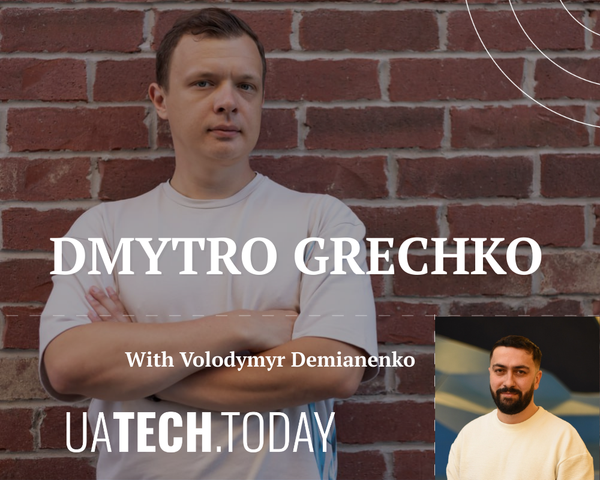With Volodymyr Demianenko
Startup advice is everywhere — podcasts, panels, pitch decks. But the most important lessons are rarely spelled out clearly. That’s what makes these insights different.
In a raw and revealing conversation with Volodymyr Demianenko, Ukrainian founder and CEO of Deskree, Dmytro Grechko shares the insights every early-stage founder wishes they had before raising the capital.
When Dmytro Grechko first set out to raise capital for his startup, he had an idea, a vision, and absolutely no connections. What he did have, however, was an extraordinary tolerance for rejection and an unmatched drive to make things happen.
Dmytro knows the hustle firsthand. As of March 2025, Dmytro’s startup 3 M, an AI cloud infrastructure platform that helps engineers to generate cloud infrastructure from application code automatically, raised $ 3 M.
But it didn’t happen overnight. In 2021, he sent over 1,200 cold emails to VCs and sat through more than 100 meetings before landing his first investment.
The journey wasn’t quick, and it wasn’t easy. And it taught him what no panel or playbook could. Now, he’s sharing that hard-earned knowledge with us.
The PTSD of Fundraising: What No One Tells You
"Fundraising," Dmytro admits, " Fundraising is one of the most PTSD-inducing Startup experiences."
Especially when you’re doing it for the first time.
The biggest misconception is that fundraising is quick. It's a process that requires an incredible amount of time, persistence, and often brutal honesty.
He walked us through his first fundraising effort in November 2021. At the time, they had a compelling idea, but no network. That made it both incredibly difficult and incredibly enlightening.
I personally reached out to 1,200 partners over 1.5 months. That’s how we found our first investors
During that period, Dmytro learned 2 key things: where to raise and how long it takes.
There are three main windows for raising funds:
- Mid-January to the end of April – before the holiday slowdown.
- Mid-May to the end of – is a dead zone.
- Mid-September to mid-November – the "golden" season.
The second most important thing that he learned was that fundraising is never a 1- or 2-month process; it takes at least 6–9 months, regardless of whether you're raising $100K or $ 5 M.
You should also expect at least 100–120 meetings.
Out of those meetings, 80% will tell you it’s interesting. And then you'll never hear from them again. Of the remaining 20%, a handful might invite you back. "Let’s loop in another partner," they'll say. But even then, only a fraction of those second conversations make it to diligence, and even fewer to an offer. Even if one partner likes you, in many funds, all partners must agree.
If ten people are on the investment committee and one says no, that’s it. You’re out.
"We had a fund where nine partners voted yes," Dmytro recalls. "And the tenth one said no. The deal died right there."
And when you pitch, you're not just pitching into a vacuum — you're competing alongside dozens of other start-ups that pitch at the same time as you. Even if an investor likes you, they might pick another startup in that time window.
Another key thing: "investors back survivors". That’s the mantra Dmytro lives by. And it’s not just a slogan — it’s backed by experience. Because in the end, it's not about finding money. It's about proving you're still here, still building, and still worth betting on.
The Truth About ‘Finding’ Investors
Dmytro shares that finding investors is not about random outreach. The best method? Ask other investors or people in the ecosystem for intros.
"Just ask for 15 minutes. Don’t pitch. Just ask for their opinion. People love sharing what they know. And if they like you, they’ll offer to connect you with others — often without you even needing to ask."
This approach turned out to be golden. Nearly 30 of his investors came through this method, not from aggressive outreach, but from genuine conversations that led to unexpected connections.
"When you meet someone interesting every week and share those intros forward, that network builds itself," he said. "It becomes a self-sustaining engine."
Today, most of the introductions Dmytro receives are inbound. Investors come to him. And many of them were introduced by other founders.
Fundraising Never Really Stops
Dmytro also learned something else along the way: fundraising doesn’t end when the round closes. In many ways, it never stops.
"You might raise for 24 months of runway," he explained. "But within 16 or 18 months, you’re already back at it. Not always raising directly — but building relationships, giving updates, showing progress."
Some of their investors only committed after a year of updates. Others joined after months of conversations.
"Every touchpoint matters," he said. "You’re planting seeds. And if you’re still standing a year later, they’ll notice."
He explained how he spends a month every quarter in Silicon Valley. Not to close deals. Not even necessarily to fundraise. But to meet people.
Exits Are Legal Games — Play to Win
While many founders dream of billion-dollar exits, Dmytro knows several who did — but walked away with less than $10 million. Not because they were diluted, but because of poorly understood investor rights written into early term sheets.
“People don’t teach you how to exit,” he said. “That’s a whole separate playbook.”
One of the biggest takeaways? Founders make lifelong legal commitments after just a few short calls. “You’re basically marrying this investor. You’ll age together — sometimes over 10 or 15 years. And you’re deciding all that after two Zoom calls.”
That’s where strong legal partners come in.
Dmytro credits much of his startup’s structural resilience to his lawyers.
“You need lawyers who, even if they screw up, know how to fix it,” he said.
It’s Not About the Product
“Here’s something most founders get wrong — VCs don’t invest in the product. They invest in the founder.”
Dmytro pointed out a surprising stat: of the 30+ investors in his company, only one had ever registered to see their platform. "That tells you everything," he said.
"Everyone’s trying to pitch a product. But what investors are really buying — especially at the early stage — is you."
If it’s your first time raising capital, he explained, investors already assume that 95% of what you’re projecting won’t go according to plan. They know that. What they want to see is whether you have the grit, self-awareness, and energy to keep pushing when things inevitably get messy.
"You’re not selling a roadmap — you’re selling your resolve. Your obsession. Your willingness to run through walls."
He summed it up in one line: "You’re not a founder trying to sell a product — you’re a product trying to sell a founder."
The Startup Dilemma for Ukrainian Founders
Volodymyr posed one last question: Are there any unique challenges for Ukrainian founders, even those who’ve moved to North America?
Dmytro took a moment to reflect. “Tough to say. “Ukrainian founders are some of the most resourceful and driven people I know. But often, they end up building businesses that generate strong cash flow rather than ones designed for venture-scale growth.”
He knows founders who scaled to $7–10M in annual revenue within a year, but hit a wall when trying to raise VC.
“Revenue doesn’t make you a start-up. Growth rate does,” he explained. "If you’re not tripling in year one and doubling for the next two, most funds won’t consider you venture-backable."
And that’s fine. Some founders are already earning millions in net profit annually, more than what they might walk away with after selling a start-up for $ 100 M.
Dmytro believes this reality needs to be normalized. “You can build a tech product. You can grow. You can be profitable. And you don’t need VC to make that a success.”
In other words: not every great business is a start-up. And not every founder needs to play by the same rules to win.



